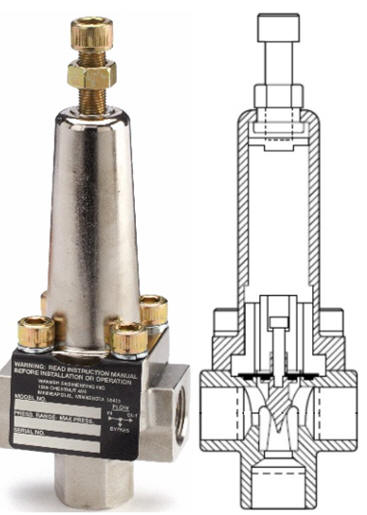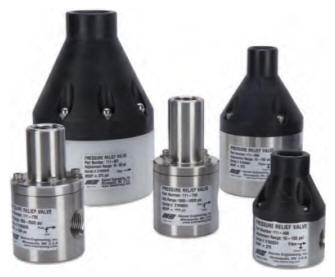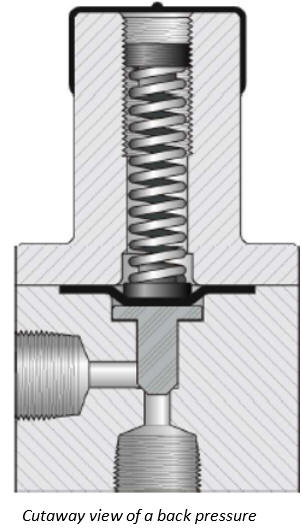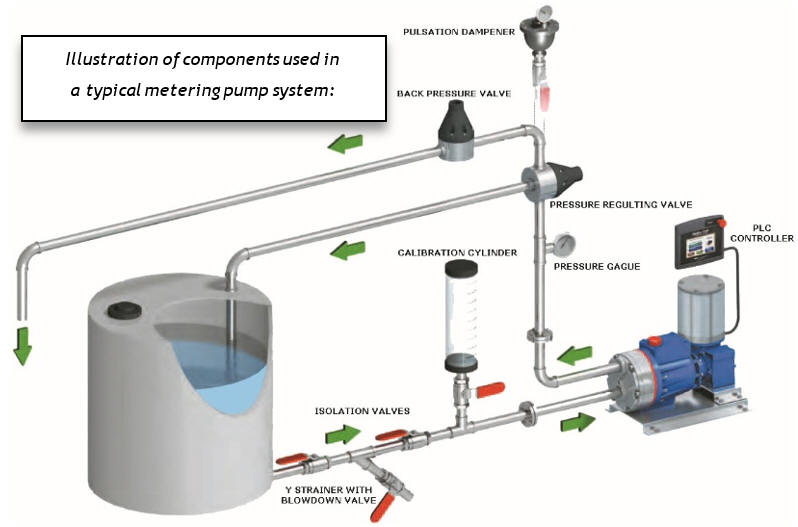Pressure Regulating and Back Pressure Valves
Comparison of valves with Application Examples
 Pressure regulating and back pressure valves look similar and are
sometimes used in the same pumping system. This article describes both
styles of valves and provides examples to assist you with your application.
Pressure regulating and back pressure valves look similar and are
sometimes used in the same pumping system. This article describes both
styles of valves and provides examples to assist you with your application.
Pressure
Regulating Valves
They are a common accessory for positive
displacement pump systems due to potential high discharge pressures which
can damage downstream equipment and processes. Examples of such equipment
include hoses, valves, filter housings and just about any other fitting or
instrument installed downstream of a positive displacement pump.
Pressure regulating valves are used to limit the
downstream pressure within an acceptable range for a given process. They
open proportionally in response to pressure, enabling bypass of flow to
ensure the maximum allowable downstream pressure is not exceeded.
 Constant
Pressure or Maximum Pressure?
Constant
Pressure or Maximum Pressure?
Positive displacement pumps
discharge a fixed volume of liquid for each rotation of its pump shaft. In
applications where pressure is not especially important, a pressure
regulating valve simply protects against over-pressurization. Transfer and
metering applications are examples that are flow centric where the pressure
may not need to remain constant and the pressure regulating valve is used to
simply prevent over-pressurization. Then there are applications requiring a
specific discharge pressure which use pressure regulating valves to maintain
that pressure even when the flow rates may vary.
Applications requiring a constant pressure across a range of
flow rates include CNC machining (several different sized tools), high
pressure washing (multiple wands or cleaning stations) and evaporative
cooling spray nozzle systems requiring constant droplet sizes (phasing in
additional atomizing spray nozzles).
Safety and Relief Valves
The nomenclature of “regulating”, “relief” and “safety” valves
are often used interchangeably so it is important to understand how you want
the valve to function for a specific application.
Safety and relief
valves are often designed to completely relieve system pressure at a certain
threshold and some designs will not automatically reset. These are used in
conjunction with pressure regulating valves to guard downstream equipment
from an instance of a failed pressure regulating valve.
A properly
sized pressure regulating valve should be able to bypass the pumps full flow
rate but will not reduce the line pressure lower than the set amount.
It is important to note that the flow path through a pressure regulating
valve is unrestricted and when the line pressure is high enough to compress
the spring seating the plunger against its seat, some flow is diverted to
the bypass port. The bypass port is often routed back to the feed tank. It
is recommended that the bypass line extends past the low liquid level of the
feed tank and as far away from the tank outlet as possible; this will
minimize entrained air and turbulence that could otherwise contribute to
pump cavitation.
If the bypass port is routed back to the inlet
piping, try to ensure it is located at least 10 pipe diameters from the pump
inlet to minimize turbulence entering the pump.
 Back
Pressure Valves
Back
Pressure Valves
This type of valve provides a restriction
greater than the downstream components or process would provide, creating a
pressure drop at the discharge port of the back pressure valve.
Unlike a pressure regulating valve, the flow path through a back
pressure valve begins fully restricted (closed) until sufficient pressure
develops to compress the spring and lift the plunger from its seat. In this
regards it is similar to a check valve except the spring tension is
adjustable and it does not control flow direction.
BBack pressure
valves benefit processes requiring minimum pressures, in the case of
Hydra-cell positive displacement pumps, a back pressure valve can improve
pumping efficiency by ensuring the discharge pressure is ≥ 30 PSI.
 Pumps
which use check valves to create a one-way flow path are usually spring
loaded to react quickly to high frequency strokes. As an example, a typical
Hydra-Cell pump operated at 1800 RPM results in 30 check valve seatings per
second. The check valve spring helps positively seat the valve and the
seating speed is further enhanced when assisted by back pressure in excess
of 30 PSI. Thus, when Hydra-Cell pumps are operated against pressures <30
PSI and without a back pressure valve, the flow rate accuracy may vary by
more than the ±1% stipulated by API 675 Metering Pump Standards.
Pumps
which use check valves to create a one-way flow path are usually spring
loaded to react quickly to high frequency strokes. As an example, a typical
Hydra-Cell pump operated at 1800 RPM results in 30 check valve seatings per
second. The check valve spring helps positively seat the valve and the
seating speed is further enhanced when assisted by back pressure in excess
of 30 PSI. Thus, when Hydra-Cell pumps are operated against pressures <30
PSI and without a back pressure valve, the flow rate accuracy may vary by
more than the ±1% stipulated by API 675 Metering Pump Standards.
Even if
your application does not require high pressure to transfer your liquid, you
might require using both a pressure regulating valve and back pressure
valve.
Positive displacement pumps and back pressure valves are
commonly used together for precise metering applications which do not
require much pressure. An example would be adding food coloring to a mixing
vessel where it is important to transfer a precise volume of fluid but the
pump only has to overcome a little more than atmospheric pressure.
TThe back pressure valve would ensure there is sufficient pressure applied to
the pumps check valves to maximize efficiency and the pressure regulating
valve would protect components from accidental over-pressurization (Positive
displacement pumps can generate nearly instantaneous spikes in pressure due
to sudden restrictions to flow).

You can learn more about each of the components illustrated above via our
website at a https://fdpp.com and you will find articles on the designs and
applications for Y strainers, ball valves, metering pumps, customized PLC
based pump control systems and pressure gauges.
We exist to help you
solve your problems in support of maximum efficiency and process quality,
call us today at 908.362.9981 for assistance with your application!





